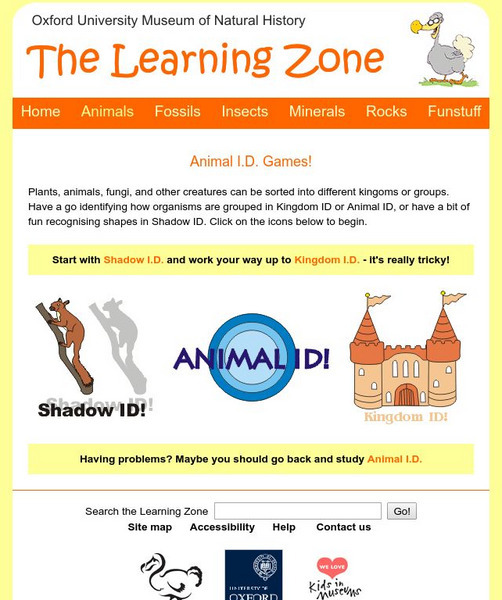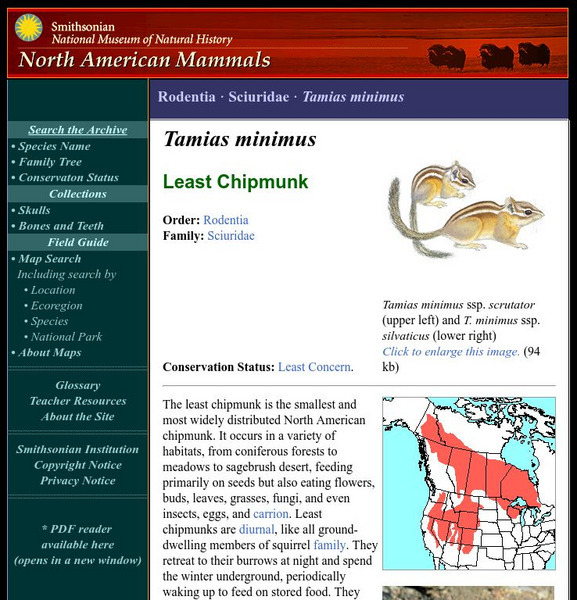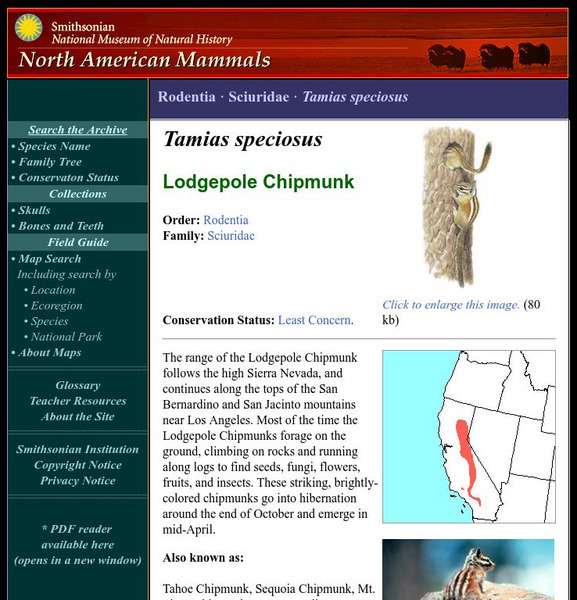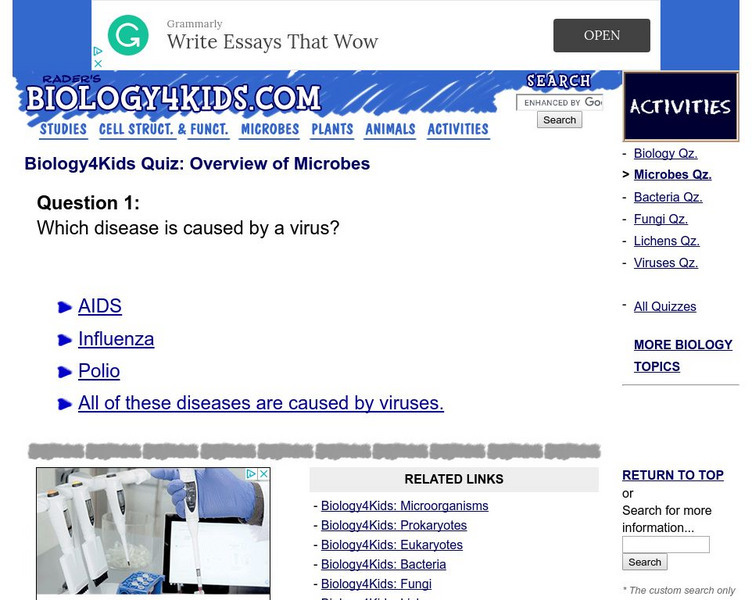Scholastic
Scholastic: Study Jams! Science: Plants: The Kingdoms of Life
A video, a karaoke song to sing along to, and a 7-question multiple-choice quiz on the topic of Kingdoms in the life classification system.
Massachusetts Institute of Technology
Mit: Inventor of the Week: Elizabeth Lee Hazen and Rachel Fuller Brown
Elizabeth Lee Hazen and Rachel Fuller Brown, inventors in New York state who developed the antifungal drug Nystatin, are featured in this brief biography.
CK-12 Foundation
Ck 12: Biology: Autotrophs and Heterotrophs
[Free Registration/Login may be required to access all resource tools.] Discusses how autotrophs and heterotrophs obtain energy.
Curated OER
Kids Health: Fungal Infections
Find out about different types of fungal infections which affect humans.
University of Oxford (UK)
Oxford University of Modern History: Animals
Plants, animals, fungi, and other creatures can be sorted into different kingoms or groups. Have a go identifying how organisms are grouped in Kingdom ID or Animal ID, or have a bit of fun recognising shapes in Shadow ID. Click on the...
Other
Math and Science Activity Center: Classification of Living Things
Kingdom is the highest rank used in the biological taxonomy of all organisms. There are 6 kingdoms in taxonomy. Every living thing comes under one of these 6 kingdoms. The six kingdoms are Eubacteria, Archae, Protista, Fungi, Plantae,...
Other
Alternative Classifications of Life
The Linnaean system (1758) classified all macroscopic living organisms as either Animals or Plants, based on whether they moved [anima, with a soul] or not. Thus, Fungi were included as plants. With the invention of the microscope and...
PBS
Pbs Teachers: Scientific American: Expedition Panama: Champion Chompers
Compare and contrast the weightlifting abilities of ants and humans and graph the results, and investigate the roles ants and fungi play in the forest ecology.
Ducksters
Ducksters: Biology for Kids: Infectious Disease
Kids learn about infectious diseases including pathogens such as viruses, bacteria, parasites, and fungi as well as transmission and other types of diseases.
Smithsonian Institution
National Museum of Natural History: American Mammals: Arizona Gray Squirrel
Walnuts are a favorite food of Arizona Gray Squirrels, and when they find an abundance, the squirrels soon stain their faces, paws, and undersides a distinct brownish-orange from walnut juice. Other foods eaten may include fungi, acorns,...
Smithsonian Institution
National Museum of Natural History: American Mammals: Long Tailed Vole
Long-tailed Voles need cool, moist habitats, so they are found mostly near the peaks of mountain ranges. Fruits and seeds make up the bulk of their diet, but they also eat fungi, bark, and leaves if necessary. Learn more about the...
Smithsonian Institution
National Museum of Natural History: American Mammals: Pacific Shrew
An inhabitant of Oregon's moist streamsides, thickets, and woods, the Pacific Shrew does best in areas with brushy vegetation and fallen decaying logs. There it finds centipedes, slugs, and snails, insect larvae, amphibians, fungi, and...
Smithsonian Institution
National Museum of Natural History: American Mammals: Least Chipmunk
The least chipmunk is the smallest and most widely distributed North American chipmunk. It occurs in a variety of habitats, from coniferous forests to meadows to sagebrush desert, feeding primarily on seeds but also eating flowers, buds,...
Smithsonian Institution
National Museum of Natural History: American Mammals: Lodgepole Chipmunk
The range of the Lodgepole Chipmunk follows the high Sierra Nevada, and continues along the tops of the San Bernardino and San Jacinto mountains near Los Angeles. Most of the time the Lodgepole Chipmunks forage on the ground, climbing on...
BiologyWise
Biology Wise: The Cell Wall Functions in Plants and Animal
Describes the composition and functions of cell walls in plants, algae, fungi, and bacteria.
Curated OER
Australian Government: Spore Release and Dispersal
The differences between active and passive spore release in fungi are explained in this thorough site.
Curated OER
Click to Enlarge
The differences between active and passive spore release in fungi are explained in this thorough site.
Curated OER
Australian Government: Spore Release and Dispersal
The differences between active and passive spore release in fungi are explained in this thorough site.
Curated OER
Australian Government: Spore Release and Dispersal
The differences between active and passive spore release in fungi are explained in this thorough site.
Centers for Disease Control and Prevention
Centers for Disease Control: Bam! Your Body: Girls' Locker Room
A virtual tour of the dangers and risks of infection lurking in a gym locker room. Girls learn about good workout practices that will keep them healthy.
Centers for Disease Control and Prevention
Centers for Disease Control: Bam! Your Body: Boys' Locker Room
A virtual tour of the dangers and risks of infection lurking in a gym locker room. Boys learn about good workout practices that will keep them healthy.
Biology 4 kids
Biology4 Kids: Quiz: Microorganisms
Take this ten-question review quiz over microorganisms. Read more about each question after an incorrect answer is given.
Wisc-Online
Wisc Online: Earth Science: Tree Health Care
Answer review questions about taking care of trees, and advance for the win!
Healthline Media
Medical News Today: What Is Ringworm?
Learn out about ringworm, a fungal infection which affects humans. Find out about the causes, risks, symptoms, diagnosis, treatment, and prevention.
Other popular searches
- Kingdom Fungi
- Protists and Fungi
- Fungi Bacteria and Virus
- Protist and Fungi
- Fungi Activity
- Fungi and Mold
- Fungi Lesson
- Biology Fungi
- Organisms, Protists, Fungi
- Yeast Fungi
- Fungi Protist
- Fungi Lab
















